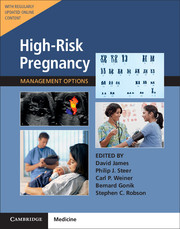Book contents
- Frontmatter
- Contents
- List of Contributors
- Preface
- Section 1 Prepregnancy Problems
- Section 2 Early Prenatal Problems
- Section 3 Late Prenatal – Fetal Problems
- 9 Prenatal Fetal Surveillance
- 10 Fetal Growth Disorders
- 11 Disorders of Amniotic Fluid
- 12 Fetal Hemolytic Disease
- 13 Fetal Thrombocytopenia
- 14 Fetal Cardiac Arrhythmias
- 15 Fetal Cardiac Abnormalities
- 16 Fetal Craniospinal and Facial Abnormalities
- 17 Fetal Genitourinary Abnormalities
- 18 Fetal Gastrointestinal and Abdominal Abnormalities
- 19 Fetal Skeletal Abnormalities
- 20 Fetal Tumors
- 21 Fetal Hydrops
- 22 Fetal Death
- Section 4 Problems Associated with Infection
- Section 5 Late Pregnancy – Maternal Problems
- Section 6 Late Prenatal – Obstetric Problems
- Section 7 Postnatal Problems
- Section 8 Normal Values
- Index
18 - Fetal Gastrointestinal and Abdominal Abnormalities
from Section 3 - Late Prenatal – Fetal Problems
- Frontmatter
- Contents
- List of Contributors
- Preface
- Section 1 Prepregnancy Problems
- Section 2 Early Prenatal Problems
- Section 3 Late Prenatal – Fetal Problems
- 9 Prenatal Fetal Surveillance
- 10 Fetal Growth Disorders
- 11 Disorders of Amniotic Fluid
- 12 Fetal Hemolytic Disease
- 13 Fetal Thrombocytopenia
- 14 Fetal Cardiac Arrhythmias
- 15 Fetal Cardiac Abnormalities
- 16 Fetal Craniospinal and Facial Abnormalities
- 17 Fetal Genitourinary Abnormalities
- 18 Fetal Gastrointestinal and Abdominal Abnormalities
- 19 Fetal Skeletal Abnormalities
- 20 Fetal Tumors
- 21 Fetal Hydrops
- 22 Fetal Death
- Section 4 Problems Associated with Infection
- Section 5 Late Pregnancy – Maternal Problems
- Section 6 Late Prenatal – Obstetric Problems
- Section 7 Postnatal Problems
- Section 8 Normal Values
- Index
Summary
Introduction
Fetal gastrointestinal and abdominal wall malformations are easily visualized by ultrasound and may be detected either during a second-trimester scan for anomalies or by chance during an examination for an unrelated indication, such as the evaluation of poor fetal growth, abnormal amniotic fluid volume (usually polyhydramnios), or an increased maternal serum α-fetoprotein (MSAFP). Increasingly these abnormalities are being detected on late firsttrimester scanning.
The most common gastrointestinal abnormalities detected antenatally are omphalocele, gastroschisis, and diaphragmatic hernia. The accuracy of ultrasound in such conditions is high, with a very low false-positive rate. Other malformations are less common and less frequently diagnosed by ultrasonography.
Following detection, the abnormality should be managed in consultation with a multidisciplinary team that provides consistent advice and treatment. Team members typically include an obstetrician with expertise in fetal medicine, a neonatal pediatrician, a pediatric surgeon, and others relevant to the case. The patient should meet with these people before delivery, either on an individual basis or in a group as needed. Parental informational needs vary with the stage in the diagnostic and treatment pathway, and those involved in counseling and management of the problem need to be aware of this.
Omphalocele (Exomphalos)
Video 18.1 Omphalocele 1
Video 18.2 Omphalocele 2
Video 18.3 Fetal megacystis and omphalocele
Video 18.4 Pentalogy of Cantrell
Video 18.5 Pentalogy of Cantrell with ectopia cordis
This is an extraembryonic hernia due to the arrest of ventral medial migration of the dermatomyotomes. Omphalocele occurs in between 1 in 2500 and 1 in 5000 pregnancies. “Physiological” herniation of abdominal contents into the base of the umbilical cord is normal up until around 11 weeks’ gestation (Figure 18.1) and must be distinguished from an omphalocele. Importantly, omphalocele is associated with other malformations 60–80% of the time, especially when the omphalocele is superior to the umbilicus. A particularly severe defect is termed the pentalogy of Cantrell, which consists of:
• an omphalocele in the supraumbilical abdominal wall
• a defect in the lower sternum
• deficiency of the anterior part of the diaphragm
• defects of the diaphragmatic part of the pericardium
• a range of cardiac abnormalities
Overall, survival in babies with an omphalocele is poor, especially when associated with major cardiac abnormalities and aneuploidy.
- Type
- Chapter
- Information
- High-Risk Pregnancy: Management OptionsFive-Year Institutional Subscription with Online Updates, pp. 433 - 471Publisher: Cambridge University PressFirst published in: 2017



